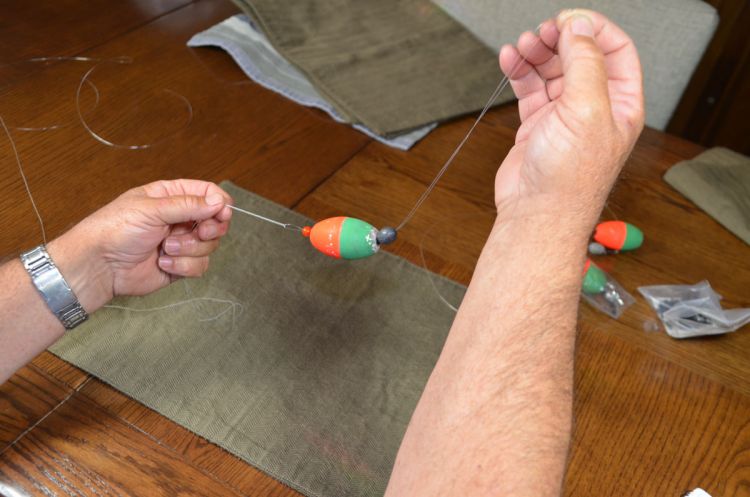
Making pre-rigs is Tommy Pellegrin’s answer to the nettlesome task of trying to put together a new rig in the middle of a hot bite. Every moment spent fiddling with lines, corks, sinkers, and hooks increases the chances of speckled trout losing interest in the area and moving off to hunt elsewhere.
1. Cut a 2-foot length of 30-pound test monofilament line and tie a black swivel on one end and a #4 Mustad UltraPoint treble hook on the other, using four-wrap improved clinch knots.
 2. Put the two ends of the leader together, doubling it. Insert the doubled end through a 3/8- to ½-ounce egg sinker and slide the sinker down to the hook and swivel ends.
2. Put the two ends of the leader together, doubling it. Insert the doubled end through a 3/8- to ½-ounce egg sinker and slide the sinker down to the hook and swivel ends.

3. Repeat the steps with a pegless cork.

4. Finish adding parts to the leader by inserting the doubled end through a plastic bead and sliding it down to the cork.
5. Coil the line and loop it on itself. Insert the rig in a small plastic zipper bag. Pellegrin likes to then store these bags of pre-rigs in a larger bag to keep them organized.

6. To put the pre-rig on line on the rod and reel, remove it from its bag and uncoil it. Insert and pull 1 foot of the reel line through the loop of the pre-rig.

7. Holding both strands of reel line in one hand, grasp the hook and swivel of the pre-rig with the other and elevate that hand enough to slide the bead, sinker, and cork from the monofilament onto the reel line.

8. Grasp the tag end of the reel line and pull it from the pre-rig and then tie it to the swivel with an 8-wrap improved clinch knot. The large number of wraps prevents the knot from slipping.

9. To make a bobber-stop, cut 10 inches of 30-pound test monofilament and tie it on the reel line above the bead with a 5-wrap uni knot. Trim the ends closely. The bobber stop can be slid up or down the line to fish at the desired depth.